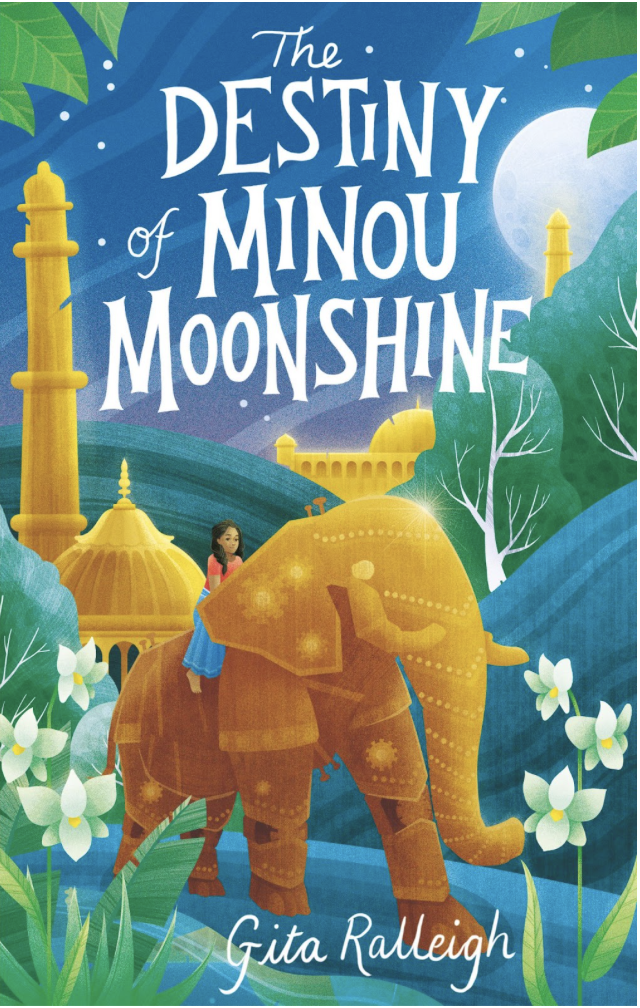Author Gita Ralleigh talks about the alternate world she created for her debut novel, The Destiny of Minou Moonshine, and the power of fantasy as an exploratory tool.

When I teach worldbuilding to my creative writing students, I encourage them to begin freely. Soon, though, we start to formulate – not rules, exactly – but the components of their world. What historical events have shaped the present? Who performs the domestic work? Who has power? Magic, if present, operates as power in fantasy worlds, often linked with wealth. What do children learn? Numeracy and literacy are prized in our schools – this may be different in the alternate worlds they create.
The world I imagined in The Destiny Of Minou Moonshine is based on a state in early 20th-century colonial South India. Minou is a poor foundling who lives in a houseboat on the river which forms a boundary dividing the city into two parts, that of the colonisers and the colonised. Moonlally, her city, is ruled over by a tyrannical General, who has usurped the real queen with the help of colonial powers. Minou attends a charity school where she learns a real Indian martial art known as Kalari.
Alternate worlds always reference the real world and are understood by readers both to adhere to reality and to veer away from it. Most elements in my alternate world can be found in real Indian history – but I knew Minou would also need power, in the form of magic, to bring the General’s regime down. I realised I was writing not just an alternative history, but a historical fantasy, set in an alternate world and concerned with crossing boundaries.
To create a believable alternate world, it’s wise to harness it to recognisable reality except for one or two magical elements: the manifestation of a goddess in The Destiny Of Minou Moonshine, a hidden archipelago of fantastical creatures in Katherine Rundell’s recent Impossible Creatures, or the rediscovery of ‘practical’ magic in 19th century England in Susanna Clarke’s Jonathan Strange And Mr Norrell.
Minou’s grandmother believes in the Dark Lady, an old goddess of Moonlally, whose worship has been suppressed by the current regime. There are no magical systems or schools of witchcraft in this world. Instead, the goddess’s power guides Minou on her quest to restore the queendom of Moonlally.
Minou, as a foundling, is free to move between the divided parts of the city and enters the General’s fortress to discover her destiny. Boundaries define children’s lives: day/night, home/school, road/pavement, work/play. In fantasy, the boundary between real and unreal is wild and overgrown, but it still exists; the reader of fantasy literature is not forbidden but encouraged to cross it.
Fantasy is sometimes derided as escapism, but its real power lies in this transgression of boundaries: life/death, animal/human, thought/action, seen/unseen. The awareness of traversing these boundaries we think of as fixed, creates awe and mystery, a feeling which fantasy writer Susan Cooper refers to as the numinous. (Susan Cooper, ‘A Catch Of The Breath’, Tolkien Lecture 2017.) The Dark Lady is both awe-inspiring and elemental, her power is linked with the weather and landscape of Moonlally.
Traditionally, children’s alternate world fantasy in the West has used medieval England as an anchoring reality – think of C.S Lewis’s Narnia, or Tolkien’s Middle-earth – while viewing the rest of the world as ‘other.’ Great examples of this are J. R. R. Tolkien’s Haradrim in the Lord Of The Rings trilogy, or C. S. Lewis’s Calormenes in the Narnia series. In many classic fantasy works, the histories and religions of ‘others’, are considered barbaric if not downright evil.
Recently, writers of other backgrounds have begun to draw on their own histories and myths to create alternate world fantasies. In The Destiny Of Minou Moonshine, I took inspiration from my own traditions. I was brought up with Hinduism, where goddesses are a central belief and both my parents and grandparents were born under colonial rule in India.
I encourage my students to draw from their own diverse real worlds, and to consider questions of power, labour, religious belief and social hierarchy in relation to magical or supernatural elements. The worlds they write about have included wars between Garuda (bird-people) and Naga (snake-people) in Sri Lankan Buddhist tales, the Meng Po soup of oblivion drunk to forget past lives in the Chinese afterlife, and the half-serpent twins of Brazilian myth.
Writing fantasy based on other cultures is not always easy. Suyi Davies Okungbowa talks of the ‘exposition tax’, whereby these writers are pressured to explain their world more than those from the dominant culture. But it’s worth doing, because if we can’t refract the beauty and diversity of the whole world – not just part of it – through the prism of our imagination, how can we hope to save it?
Constructing alternate worlds with young writers helps them examine and question how their own world has been constructed, and how it can be made into a better place. As the fantasy writer Ursula Le Guin stated in her National Book Award acceptance speech of 2014: “Resistance and change often begin in art. Very often in our art, the art of words.”
This article was written for Write On! and first appeared on their website, pentoprint.org.
Gita Ralleigh is a poet, writer and doctor born to Indian immigrant parents in London. She teaches creative writing to science undergraduates at Imperial College and has an MA in Creative Writing and an MSc in Medical Humanities. Her poetry books are A Terrible Thing (Bad Betty Press, 2020) and Siren (Broken Sleep Books, 2022). Her debut children’s novel, The Destiny Of Minou Moonshine, is out now from Zephyr/Head Of Zeus.
Comments